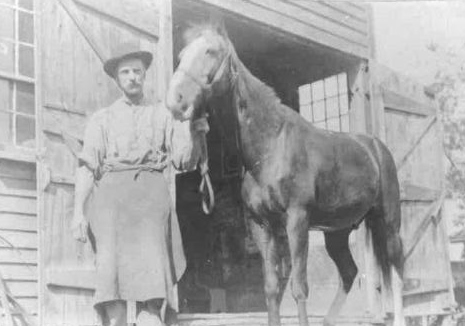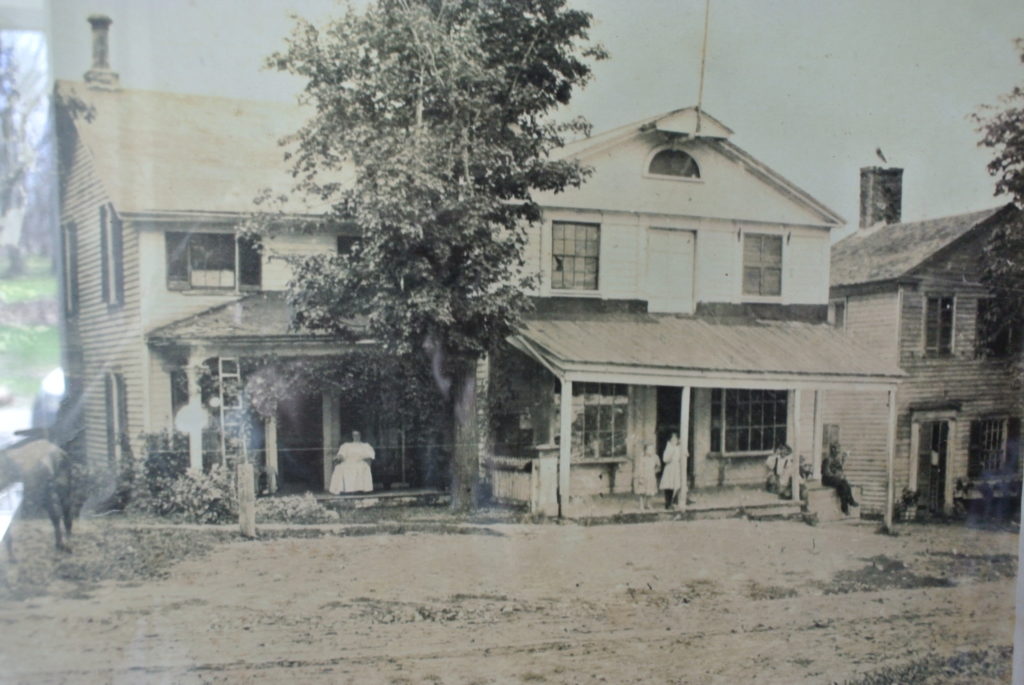Allens Hill: The shops and markets
by Joy Lewis –

William Henry Shelton, who grew up in Allen’s Hill in the 1850s and wrote extensively of his boyhood, provides a succinct description of his hometown: “Let the reader picture to himself a hill, on the top of which is a space of five-and-twenty acres, and across it a coach-road, which forms the main street. A traveler, entering it from the east, would observe a row of neat white houses on the right, most of them embowered in trees, with gardens behind; while on the left is a handsome farm [and orchard].”
A pretty little village was Allen’s Hill, with its “neat white houses,” its hill-top church, and its busy shops. But it was not always so. Nearly half a century of its history had passed before Shelton came on the scene. In the early years of the nineteenth century Allen’s Hill was yet a-borning.
The first commercial enterprise to appear on the hill was the 1801 blacksmith shop of Nathaniel Allen. This was a good-sized brick structure in the backyard of the present-day house that anchors the northwest corner of Allens Hill Road and Belcher Road. Allen sold his blacksmith business to Charles Pierpont in 1816, who then worked the forge for about twenty years. By the late thirties the building was used simply as a storage barn.
Then a second blacksmith shop appeared on the scene. This was a large wooden building, of two stories, just a bit north of the Pierpont forge. (Many years later this property was owned by Richard Allen; it stood in the far backyard of the home on Allens Hill Road that in 2018 is #3832.) John West, brother of the Allen’s Hill doctor, was the blacksmith.
William Shelton remembered the escapades of the local youths as they played about the dooryard: “The blacksmith hammered at his anvil and shod the horses of the farmers and set the tires of wagon-wheels in a circle of burning fagots outside the shop door…Attracted by the [ring of fire the schoolboys, one after the other] would jump into the circle of flame and jump out again.”
At mid-century blacksmith Thomas Lambert came from England and set up his smithy at the other end of Allen’s Hill – on Belcher Road, on a lot west of the tavern and east of the shoemaker’s shop. His arrival on the stage was noted: “He was a brawny man, with big fists and sinewy arms, in a drab greatcoat having a graduated series of small capes at the shoulder, and he had a curious twinkle in his eye as he faced about and looked down the road through the village.” With him were his wife Mary Ann and their two adolescent children: Noah and Lucy.
The new blacksmithing business was profitable: so much so that Lambert drove the competing blacksmith out of the village. John West moved his family to Bristol and the big forge on Allens Hill Road sat empty for three decades.
Then changes came to Lambert’s shop in the 1860s and 70s. Tom moved his operation to the northeast corner of Allens Hill Road and Bell Road and moved into the house recently vacated by the Seeley family. When the elder Lambert died in 1876, his son Noah took over the business. Noah bought the old tavern – the building on Belcher Road that had begun its life as the home of Peter Allen – removed it from its moorings, and brought it clear across the village to be reconfigured as a forge.
For thirty years Noah worked here. Then on April 11, 1902, this notice (here abridged) appeared in the Livonia Gazette: “This entire community was terribly shocked Thursday morning of last week to learn that Noah Lambert had taken his life by hanging, his body having been found suspended from a beam in the barn. He had been unable to work at his trade, that of a blacksmith, for several days, and had seemed in very low spirits, but that morning, said he was better and would go to the shop. Mr. Lambert leaves a wife, and seven daughters. He was a notedly industrious man and had many friends among his numerous patrons.” His son-in-law Henry Killips took over the smithy

There were other shops and businesses in Allen’s Hill – a shoemaker, a cooper, a doctor (after 1832), and a few merchants. The first shoemaker in town, Daniel Holmes, had a home near the cemetery. His shop, a tidy brick building, was on the north side of Belcher Road, just a bit west of Tom Lambert’s original forge. In 1840 the Sam Tongate family arrived from England. He was a shoemaker hired by Mr. Holmes. Eventually Tongate bought the shop and operated it for many years. His son, also called Sam, married the neighbor girl, Lucy Lambert, the blacksmith’s daughter. But they did not live happily ever after.
The first mercantile in Allen’s Hill was housed in the cooperage, on the east side of the village green, next door to the minister’s house. In 1809 entrepreneur George McClure showed up with a stock of window glass, buttons, tobacco, dyes, and pottery which he stored in the cooperage. He hired a clerk to oversee the operation, which lasted about a year before he realized there was no profit to be made. Five years passed before Samuel Caldwell repeated the experiment; he lasted nearly a decade. John Dixon, who had a large store in West Richmond, came next (in 1829) and remained for about five years. After 1834 the old cooperage-cum-mercantile stood empty.
The next store in town was located on the east side of Allens Hill Road, north of the corner (nearly opposite of where the library stands today). Its builder and proprietor in the 1830s were Hiram Merriman and David A. Pierpont. In the 1850s John Henry Goodsell (perfect name for a merchant!) owned the store; his brother Charles was the clerk as well as the Postmaster.
The list of items for sale at this time was long and varied and included: apples, oranges and lemons, butter, cheese, milk, eggs, tea, coffee, honey, a conical loaf of sugar wrapped in blue paper, a Paisley shawl, clay pipes, parasols, lamps, a boy’s hat costing 10¢, an umbrella and gum-rubber overshoes, thread, ginger and other spices, wheat, codfish, oysters in wooden kegs, calico, muslin, lawn, wool, whale oil, writing paper, a steel pen, and sealing wax.
Meat, however, could not be purchased at the store, nor could tin-ware. Both these items were sold by peddlers who brought their wagons up the hill from Honeoye. Crackers were another commodity that could not be purchased at the store. Once a year, in the autumn, came a traveling baker who spent a day or two in various households, turning out his savory goods. “After sprinting for two days between the buttery and the brick oven he left behind him a barrel of crackers and half-barrel of gingersnaps and trotted away with his pans on his back.”
There was a third store in Allen’s Hill, this one remembered still by present-day members of the community. In 1859 Mortimer Worthy came to town and bought the Robert L. Rose farm (on the south side of Belcher Road), paying over twenty-seven thousand dollars. Two years later he bought an empty lot across the road and built upon it a large General Store. He operated the store for twenty years; then his son Marion was there for another half-decade. Though other proprietors came along in later years (Charlie Simmons and Clay Francis among them), the store was called “Worthy’s” for a long, long time.
 Joy Lewis has been the Town of Richmond Historian since 2013. For town of Richmond history you can contact the Historian by Phone: 585-229-1128;
Joy Lewis has been the Town of Richmond Historian since 2013. For town of Richmond history you can contact the Historian by Phone: 585-229-1128;
or Email: historian@townofrichmond.org